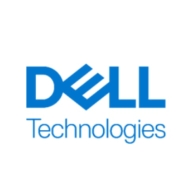

Dell PowerMax and Pure FlashArray X NVMe compete in the high-performance storage solutions category. Dell PowerMax seems to have the upper hand due to its features like data compression and integration options, while Pure FlashArray X NVMe stands out for its simplicity and high reliability.
Features: Dell PowerMax offers reliable NVMe-based back-ends, data compression, and extensive replication with SRDF, ensuring data integrity and seamless management with CloudIQ. Pure FlashArray X NVMe is known for its high-speed operations, efficient data reduction, and ease of deployment, suitable for demanding environments.
Room for Improvement: Dell PowerMax could enhance deduplication efficiency, automation capabilities, and support for NVMe over Fabrics. User feedback suggests improvements in its GUI and disaster recovery setup. Pure FlashArray X NVMe needs better deduplication rates, enhanced replication capabilities, and pricing adjustments, along with improved data analytics features and cloud integration.
Ease of Deployment and Customer Service: Dell PowerMax is mainly deployed on-premises, supported by strong technical service, although conflict resolution times could improve. Pure FlashArray X NVMe, also deployed on-premises with public cloud options, is praised for its setup ease and strong support, though cost remains a concern.
Pricing and ROI: Dell PowerMax reflects its high-end features in its pricing, offering good ROI through efficient management. While some users seek better price points, it provides excellent total cost of ownership. Pure FlashArray X NVMe is cost-effective but still scrutinized over its price, yet it delivers high ROI due to performance benefits and simplified management.
During a DCDR setup and migration from VMAX to Dell PowerMax, what was planned as a two-day downtime was completed in just three to four hours.
The performance metrics or benchmarks I use to measure success with Dell PowerMax include uptime as well as our response times on our platforms, both of which are exactly where we want them to be, which is five nines and as fast as possible.
My client has seen significant ROI since the install, and when you don't go down, that's an ROI in and of itself.
By opting for the gold subscription every three years, you get a free upgrade to the latest controller release.
If you wait more than seven years to buy another one, you get a return on your investment.
I would rate Dell PowerMax support as a ten, as I have never had an issue with Dell support as it relates to this product.
ProSupport Next Business Day offers part replacement within four hours for data leaks.
Dell support for Dell PowerMax is exceptional, rating a perfect 10 out of 10.
We also had one outage where a controller of one of the products had failed and had to be replaced on-site.
Customers always have their issues resolved promptly.
Technical support is good at least through vendors, not directly with the principal.
Scalability is not an issue.
Dell PowerMax is good for enterprises, and it also depends on how much workload you're going to bring in on Dell PowerMax in terms of performance and how many users are going to use the database you're hosting.
PowerScale is better suited for AI and overall buzz solution currently.
It is highly scalable.
It is suitable for both medium-sized and enterprise businesses.
It hasn't broken down anytime in the last six to seven years, despite hurricanes, earthquakes, and power outages.
These patches can be applied on the fly without requiring software upgrades or system downtime.
I would rate it nine out of ten since there are no required downtimes, even during firmware upgrades.
There has been no downtime with Dell PowerMax; it's been extremely reliable, easy to manage, easy to upgrade, and trustworthy as we've upgraded over the years from one version to another.
I would rate the stability of the solution as a ten out of ten.
I would rate the stability of the product at seven out of ten.
Compared to competitors such as NetApp, which integrates with public cloud hyperscalers (GCP, Azure, AWS), Dell PowerMax lacks in this aspect.
Dell can assist by providing plug-and-play integrated templates that allow customers to drag, drop, modify, and connect with any target system for generating snapshots without logging into the storage directly.
Dell PowerMax NVMe is very reliable storage and cannot experience downtime.
We would appreciate a built-in transparent failover in the next release to eliminate the need for a separate metro cluster.
I'm eagerly anticipating the roadmap's promise of introducing multiple controllers, which could significantly boost scalability and resilience.
We mostly rely on long-term releases. We don't need the most up-to-date features, but we need a reliable environment.
The higher cost compared to other vendors is justified by additional features, vendor-managed upgrades, and superior support services.
It is the best choice for large projects in terms of price and features compared to midrange solutions.
The price is starting from $500,000.
While the prices may be higher than those of other vendors, we see it as a market leader with benefits.
The support can be a bit pricey, but the solution is more cost-effective than anything else out there.
I would give it a nine out of ten in terms of costliness.
NVMe provides additional fast cache, similar to random access memory (RAM), which improves overall system performance and read/write experience for users.
Dell PowerMax NVMe is very supportive of our operational growth since we require daily performance from our core banking systems and need to facilitate data movement efficiently.
The key benefits of using Dell PowerMax, quantified in terms of saved hours and saved costs, is having one single platform that provides functionality to all of our internal customers.
The platform's robust features include excellent sustainability tracking, and a comprehensive dashboard offering insights into IOPS, bandwidth, performance, and virtual activities.
Its data compression feature is the best that we have ever seen.
The standout features for us in Pure FlashArray X NVMe are its robust DDoS protection, seamless transparent failover, and failback capabilities ensuring high availability.
| Product | Market Share (%) |
|---|---|
| Dell PowerMax | 9.1% |
| Pure FlashArray X NVMe | 3.3% |
| Other | 87.6% |


| Company Size | Count |
|---|---|
| Small Business | 17 |
| Midsize Enterprise | 16 |
| Large Enterprise | 54 |
| Company Size | Count |
|---|---|
| Small Business | 15 |
| Midsize Enterprise | 11 |
| Large Enterprise | 12 |
PowerMax leads in mission-critical enterprise storage with advanced architecture and AI-driven automation, ensuring secure and efficient IT optimization. Its multi-node NVMe scale-out framework delivers unmatched performance and consolidation, backed by Dell’s Future-Proof Program.
PowerMax is renowned for its robust reliability, performance, and efficient data reduction capabilities. Users benefit from its NVMe architecture, aiding significant scalability and cost efficiency through effective deduplication and compression. Unisphere simplifies management, while CloudIQ provides enhanced monitoring. With high availability and strong IOPS capabilities, PowerMax effectively manages demanding workloads and ensures seamless operations. Its compact design and increased storage capacity enhance user experience, particularly with easy maintenance and robust performance.
What are the key features of PowerMax?Dell PowerMax is predominantly employed in mission-critical applications such as SQL, Oracle databases, ERP systems, and high transactional environments. Healthcare, finance, and e-commerce sectors leverage its high performance, scalability, and NVMe technology for low latency and redundancy. It is adept in storage consolidation, data analytics, and disaster recovery.
Pure Storage FlashArray//X is the world’s first enterprise-class, all-NVMe flash storage array. It represents a new class of storage – shared accelerated storage, which is a term coined by Gartner – that delivers major breakthroughs in performance, simplicity, and consolidation.
We monitor all NVMe All-Flash Storage Arrays reviews to prevent fraudulent reviews and keep review quality high. We do not post reviews by company employees or direct competitors. We validate each review for authenticity via cross-reference with LinkedIn, and personal follow-up with the reviewer when necessary.